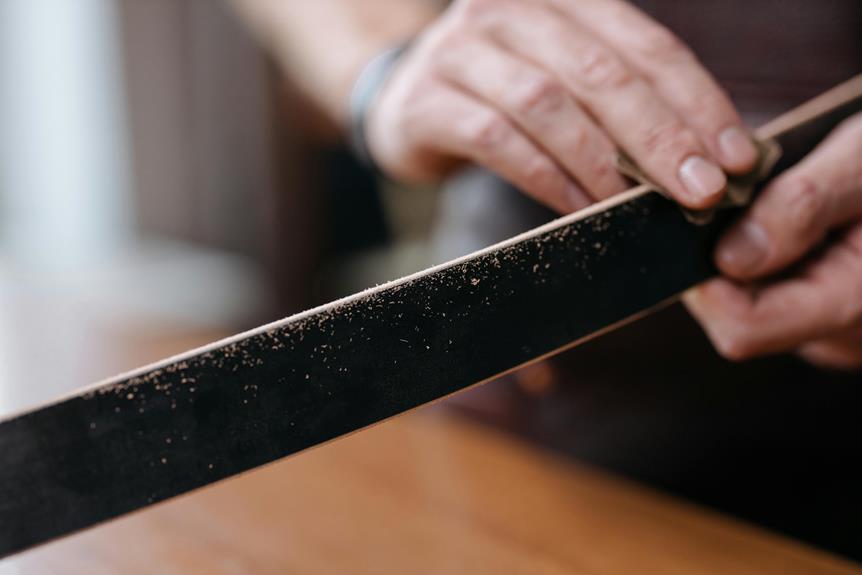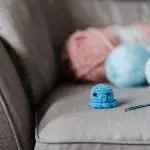When it comes to tackling starch residue, you might find yourself wondering which methods truly work best. Soaking your cookware in hot, soapy water can loosen stubborn remnants, but that's just the start. Applying a baking soda paste and rinsing with a vinegar-water mix can enhance your cleaning routine significantly. However, it's not just about cleaning; prevention plays a crucial role too. What if there are strategies you haven't considered that could save you time and effort in the long run?
Table of Contents
Key Takeaways
- Soak cookware in hot, soapy water to loosen starch residue before scrubbing for easier removal.
- Apply a baking soda paste to stubborn areas, allowing it to sit for 15 minutes before scrubbing gently.
- Use a vinegar-water mixture to effectively break down and eliminate remaining starch residue.
- Rinse kitchenware immediately after use with cold water to prevent residue from hardening.
Understanding Starch Residue
Starch residue is the leftover sticky substance that can cling to cookware and utensils after cooking starchy foods like pasta or potatoes. It forms when starches gelatinize and then cool, leaving a gluey film that's tough to remove. You might notice this residue on pots, pans, and even serving dishes, making cleanup more challenging.
This residue can be problematic, not just for hygiene but also for the longevity of your cookware. If you don't address it quickly, it can harden and become even more difficult to clean. Plus, it can affect the taste of your food if you don't remove it properly before cooking again.
Understanding how starch behaves during cooking helps you tackle the problem more effectively. When starch granules absorb water and heat, they swell and eventually burst, releasing the sticky substance.
Knowing this, you can take proactive measures to prevent build-up. For instance, rinsing your cookware promptly after use can minimize residue formation. By being aware of how starch interacts with your cooking tools, you'll make cleaning easier and ensure your next culinary adventure is as enjoyable as possible.
Effective Laundry Techniques
To tackle tough stains and odors effectively, you need to adopt the right laundry techniques.
Start by sorting your laundry based on fabric type and color. This step ensures that delicate fabrics don't get damaged and that colors don't bleed.
Next, treat any visible stains before washing. Apply a stain remover directly to the affected area, letting it sit for at least five minutes. For starch residue, consider using a mixture of warm water and a mild detergent. Gently rub the solution into the fabric for optimal results.
When washing, choose the appropriate cycle. For heavily soiled items, a heavy-duty cycle often works best. Always use the correct water temperature, as hot water can help dissolve starch residue, while cold water is suitable for delicate fabrics.
Don't forget about the detergent! Use a high-quality detergent that targets stains and residue. After washing, check your garments for any lingering starch. If you still see it, repeat the process before drying.
Kitchenware Cleaning Methods
Effective kitchenware cleaning methods are essential for maintaining hygiene and ensuring your cooking tools last longer.
When you're dealing with stubborn starch residue, it's crucial to use the right approach. Here are some effective methods to keep your kitchenware sparkling clean:
- Hot Soapy Water: Soak your utensils and pots in hot, soapy water to loosen up the residue.
- Baking Soda Paste: Create a paste with baking soda and water, apply it to the affected areas, and scrub gently.
- Vinegar Rinse: After washing, rinse your kitchenware with a mixture of vinegar and water to cut through any remaining starch.
- Dishwasher Cycle: If your kitchenware is dishwasher-safe, run it through a cycle for a thorough clean.
Natural Remedies for Starch
When it comes to tackling stubborn starch residues, natural remedies can offer effective solutions that are safe for both your kitchenware and the environment.
One of the simplest methods involves using white vinegar. Mix equal parts of water and vinegar in a spray bottle, and spritz the affected areas. Let it sit for about 10 minutes, then wipe it away with a clean cloth. The acidity in vinegar breaks down starch, making it easier to remove.
Another great option is baking soda. Create a paste by mixing baking soda with a little water. Apply this paste to the starch residue, let it sit for 15 minutes, and gently scrub with a sponge or cloth. Rinse thoroughly afterward to ensure no residue remains.
You can also try lemon juice, known for its natural acidity. Apply lemon juice directly onto the starch-stained surface, let it sit for a few minutes, and wipe it clean.
Lastly, hot water can work wonders. Boil water and pour it over the area with starch residue. This can help loosen the particles, making them easier to clean.
These natural remedies are effective, eco-friendly, and easy to use!
Preventing Future Starch Build-up
Keeping your kitchenware clean starts with simple habits that prevent starch build-up in the first place. By adopting a few proactive strategies, you can keep your utensils and surfaces free from sticky residues. Here are some effective tips to help you maintain a starch-free kitchen:
- Rinse immediately: After using cookware that contains starch, rinse it right away to prevent residue from drying and sticking.
- Use cold water: When rinsing, use cold water to help lift starches off surfaces more effectively.
- Choose non-starchy alternatives: Whenever possible, opt for non-starchy ingredients that won't leave behind sticky residues.
- Regularly clean your tools: Make it a habit to deep clean your cutting boards, pots, and pans regularly to remove any hidden starch build-up.
Frequently Asked Questions
Can Starch Residue Cause Fabric Discoloration Over Time?
Yes, starch residue can cause fabric discoloration over time. If you don't remove it properly, the residue can attract dirt and grime, leading to yellowing or dullness in your clothes. Regular cleaning helps prevent this.
Is Starch Residue Harmful to Skin or Health?
Starch residue isn't typically harmful to your skin or health. However, if you have sensitive skin, it might cause irritation. It's best to wash fabrics thoroughly to avoid any potential discomfort or reactions.
How Does Starch Residue Affect the Lifespan of Kitchenware?
Starch residue can cling to your kitchenware, leading to potential buildup and damage over time. If you don't clean it properly, you might shorten the lifespan of your pots, pans, and utensils significantly.
Are There Special Detergents Designed for Starch Removal?
Yes, there are special detergents formulated to tackle starch buildup. These products often contain enzymes that break down starch molecules, making it easier for you to clean your kitchenware effectively and maintain its longevity.
Can Starch Residue Attract Pests or Insects?
Yes, starch residue can attract pests or insects. They're drawn to the carbohydrates in starch, which can lead to infestations. Keeping surfaces clean and free from residue helps prevent these unwanted visitors in your space.
- Tetron Fabric for Marine Applications: Durability and Use Cases - June 18, 2025
- Tetron Fabric for Outdoor Furniture: Weather Resistance and Care - June 18, 2025
- Tetron Fabric for Wall Coverings: Style and Application Tips - June 18, 2025







